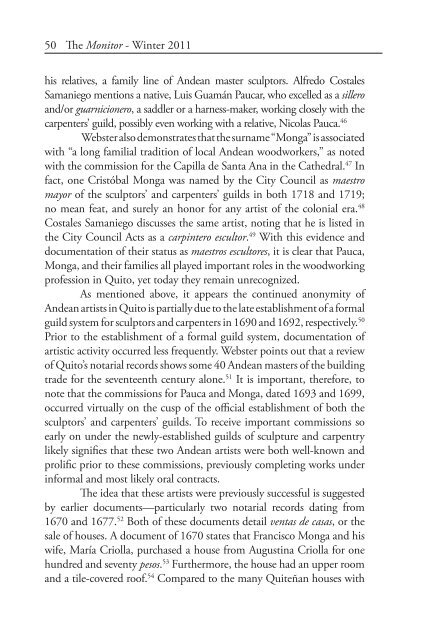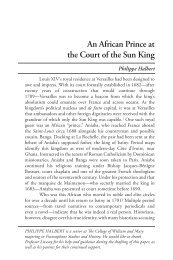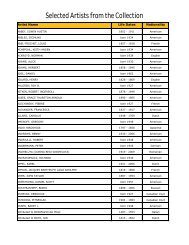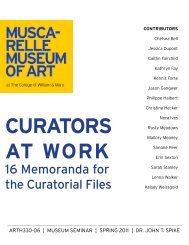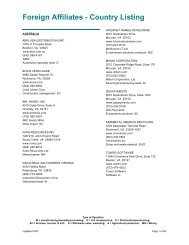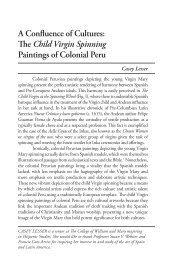Andean Artists in Colonial Quito: - College of William and Mary
Andean Artists in Colonial Quito: - College of William and Mary
Andean Artists in Colonial Quito: - College of William and Mary
Create successful ePaper yourself
Turn your PDF publications into a flip-book with our unique Google optimized e-Paper software.
50 The Monitor - W<strong>in</strong>ter 2011<br />
his relatives, a family l<strong>in</strong>e <strong>of</strong> <strong>Andean</strong> master sculptors. Alfredo Costales<br />
Samaniego mentions a native, Luis Guamán Paucar, who excelled as a sillero<br />
<strong>and</strong>/or guarnicionero, a saddler or a harness-maker, work<strong>in</strong>g closely with the<br />
carpenters’ guild, possibly even work<strong>in</strong>g with a relative, Nicolas Pauca. 46<br />
Webster also demonstrates that the surname “Monga” is associated<br />
with “a long familial tradition <strong>of</strong> local <strong>Andean</strong> woodworkers,” as noted<br />
with the commission for the Capilla de Santa Ana <strong>in</strong> the Cathedral. 47 In<br />
fact, one Cristóbal Monga was named by the City Council as maestro<br />
mayor <strong>of</strong> the sculptors’ <strong>and</strong> carpenters’ guilds <strong>in</strong> both 1718 <strong>and</strong> 1719;<br />
no mean feat, <strong>and</strong> surely an honor for any artist <strong>of</strong> the colonial era. 48<br />
Costales Samaniego discusses the same artist, not<strong>in</strong>g that he is listed <strong>in</strong><br />
the City Council Acts as a carp<strong>in</strong>tero escultor. 49 With this evidence <strong>and</strong><br />
documentation <strong>of</strong> their status as maestros escultores, it is clear that Pauca,<br />
Monga, <strong>and</strong> their families all played important roles <strong>in</strong> the woodwork<strong>in</strong>g<br />
pr<strong>of</strong>ession <strong>in</strong> <strong>Quito</strong>, yet today they rema<strong>in</strong> unrecognized.<br />
As mentioned above, it appears the cont<strong>in</strong>ued anonymity <strong>of</strong><br />
<strong>Andean</strong> artists <strong>in</strong> <strong>Quito</strong> is partially due to the late establishment <strong>of</strong> a formal<br />
guild system for sculptors <strong>and</strong> carpenters <strong>in</strong> 1690 <strong>and</strong> 1692, respectively. 50<br />
Prior to the establishment <strong>of</strong> a formal guild system, documentation <strong>of</strong><br />
artistic activity occurred less frequently. Webster po<strong>in</strong>ts out that a review<br />
<strong>of</strong> <strong>Quito</strong>’s notarial records shows some 40 <strong>Andean</strong> masters <strong>of</strong> the build<strong>in</strong>g<br />
trade for the seventeenth century alone. 51 It is important, therefore, to<br />
note that the commissions for Pauca <strong>and</strong> Monga, dated 1693 <strong>and</strong> 1699,<br />
occurred virtually on the cusp <strong>of</strong> the <strong>of</strong>ficial establishment <strong>of</strong> both the<br />
sculptors’ <strong>and</strong> carpenters’ guilds. To receive important commissions so<br />
early on under the newly-established guilds <strong>of</strong> sculpture <strong>and</strong> carpentry<br />
likely signifies that these two <strong>Andean</strong> artists were both well-known <strong>and</strong><br />
prolific prior to these commissions, previously complet<strong>in</strong>g works under<br />
<strong>in</strong>formal <strong>and</strong> most likely oral contracts.<br />
The idea that these artists were previously successful is suggested<br />
by earlier documents—particularly two notarial records dat<strong>in</strong>g from<br />
1670 <strong>and</strong> 1677. 52 Both <strong>of</strong> these documents detail ventas de casas, or the<br />
sale <strong>of</strong> houses. A document <strong>of</strong> 1670 states that Francisco Monga <strong>and</strong> his<br />
wife, María Criolla, purchased a house from August<strong>in</strong>a Criolla for one<br />
hundred <strong>and</strong> seventy pesos. 53 Furthermore, the house had an upper room<br />
<strong>and</strong> a tile-covered ro<strong>of</strong>. 54 Compared to the many Quiteñan houses with


